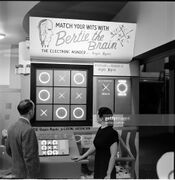Bertie the Brain: Difference between revisions
From Videogame Morgue File
MorgueFile (talk | contribs) m (→Photos) |
m (Added history section) |
||
| Line 1: | Line 1: | ||
{{Infobox | {{Infobox | ||
|title = Bertie the Brain | |title = Bertie the Brain | ||
|image = | |image = BertietheBrainDemonstration.jpg | ||
|developer = Josef Kates | |developer = Josef Kates | ||
|date = 1950 | |date = 1950 | ||
|mobygames = https://www.mobygames.com/game/arcade/bertie-the-brain | |mobygames = https://www.mobygames.com/game/arcade/bertie-the-brain | ||
}} | }} | ||
Bertie the Brain was a single purpose computer created in 1950 by the scientist Dr. Josef Kates which played the game tic-tac-toe (naughts and crosses). The machine was built as a display of Kates' invention, the Binary Adder Tube, a vacuum tube he believed had the potential to obsolete the older models in performance. Bertie is the earliest known, fully electronic device used to play a game, with some labelling it as the very first video game. It was showcased at the Canadian National Exhibition in Toronto, Canada from August to September 1950 and was afterwards disassembled for parts. | |||
== Photos == | == Photos == | ||
Latest revision as of 21:55, 8 January 2022
Bertie the Brain was a single purpose computer created in 1950 by the scientist Dr. Josef Kates which played the game tic-tac-toe (naughts and crosses). The machine was built as a display of Kates' invention, the Binary Adder Tube, a vacuum tube he believed had the potential to obsolete the older models in performance. Bertie is the earliest known, fully electronic device used to play a game, with some labelling it as the very first video game. It was showcased at the Canadian National Exhibition in Toronto, Canada from August to September 1950 and was afterwards disassembled for parts.
Photos[edit]
Histories[edit]
- http://spacing.ca/toronto/2014/08/13/meet-bertie-brain-worlds-first-arcade-game-built-toronto/ Meet Bertie the Brain, the world’s first arcade game, built in Toronto by JChris Bateman.



